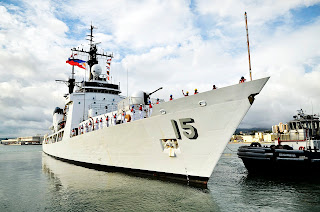Chinese fishing boat crew resisted being boarded in the latest clash over diminishing fishing stocks in the Yellow Sea stabbed to death a Korean Coastguard
A tribute to the South Korean coastguard officer Lee Cheong-ho, who was stabbed to death while trying to board a Chinese fishing boat. Photograph: Yonhap/EPA
The bloody dispute over diminishing fish stocks in the Yellow Sea has claimed another victim when the South Korean coastguard said one of its officers was fatally stabbed while trying to seize a Chinese fishing boat.
The killing, which prompted a diplomatic protest by Seoul, is the latest in a series of deadly clashes involving Chinese fishermen who are driven increasingly far from their own shores by the lack of stocks.
The officer was stabbed in the stomach and another injured when the Chinese crew resisted being boarded as they were fishing illegally about 55 miles (90km) from Socheong Island, the South Korean coastguard said in a statement.
A helicopter took the casualties to a hospital in Incheon, along with the Chinese boat captain, who was allegedly responsible for the stabbing and then injured in the fight, it said. The remaining eight crew members and their boat have been seized and are being taken to Incheon port, west of Seoul.
South Korea's foreign ministry summoned China's ambassador later on Monday and lodged a strong protest over the latest skirmish in an area of the Yellow Sea that Seoul claims as its exclusive economic zone.
As competition for mackerel, jellyfish, blue crab, croaker and anchovy has intensified, South Korea has seized about 470 Chinese ships for illegal fishing in the Yellow Sea so far this year, up from 370 in 2010.
The skirmishes are often violent. Last December, Beijing demanded compensation after a Chinese fisherman was killed and another went missing during a confrontation between South Korean coastguards and 50 vessels that were suspected of fishing illegally. In March, a coastguard official shot a Chinese fisherman in the leg during a fight with axes and shovels. Two months ago, South Korean coastguard officials used teargas to arrest 31 fisherman who resisted with shovels and staves.
The disputes are not so much about protecting fish stocks as competing for the economic exploitation of what is left. The market for anchovy, jellyfish, mackerel and croaker is increasingly lucrative as demand grows in China.
South Korea has ramped up its exports of marine products by more than 30% in the first nine months of this year, largely thanks to shipments to China more than doubling.
Last week, Seoul raised fines on illegal fishing by foreign boats and moves are afoot to change the law so catches can be confiscated.
"Eradicating Chinese boats' illegal fishing in our waters is a most urgent task to safeguard our fishermen and fisheries resources," South Korea's Yonhap news agency said in a recent editorial. "The government should mobilize every possible means and continue the crackdown on illegal fishing."
The East Asian neighbors have tried to ease tensions. In October, they agreed to reduce catches in each other's exclusive economic zones. Authorities in China's Liaoning province – the origin of many of the fishing boats – say they have tried to curb illegal fishing. But the domestic media say fishermen are driven further from the Chinese coast by pollution and overfishing.
Lu Chao of the Liaoning Academy of Social Science said the long-term problem was an excess of Chinese fishing boats, declining fish stocks and changing views about which waters belonged to which country.
"Traditionally, the older generation believed the fishing area belongs to China. Their grandchildren know they should get permission from the South Korean government to fish there, but the license is expensive so only 10% of them get it," he said in calling for calm. "If South Korea continues to enforce the law violently, it will increase conflict. The use of teargas and similar measures is excessive. Chinese fishermen will not stand for this treatment.
He said the Chinese government was trying to ease bilateral tension by encouraging fishermen to sail even further offshore, into international waters. But with demand for marine products rising, this looks likely to shift the pressure from East Asia on to global fish stocks.
Fishing has heightened diplomatic tensions with other nations in the region. In September 2010, Japan detained a Chinese trawler and its crew after a collision with a coastguard vessel.
The issue has also become the focus of long-standing territorial disputes, particularly in the South China Sea, where Beijing's efforts to assert sovereignty has led to unease – and occasional clashes – with the fishing boats and naval vessels of Vietnam and the Philippines.
Tribute to the Korean Victim: We encouraged all the readers to offer a short prayer for peace in all the country surrounding china and hope that there is a divine intervention for any conflict in the sea and we pray that china must learn how to be contented of what they had and they must stop invading neighbors.
To our Filipino Brothers: You must not forget that the Philippines lead for the victory of the South Korea over the communist North Korea during the Korean war; Filipinos' love to South Korea is already a culture. After the Korean War, the Philippines government helps the South Korea to stand up by funding and building infrastructure for their country, now even South Korea is already rich and more richer than the Philippines in terms of economy, still the Philippines is always be at the back of South Korea. Filipinos let hand in hand with South Korea as we are facing the same conflict with China.





















